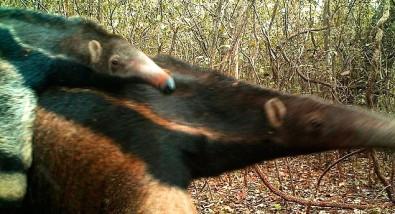
Credit: Fundação de Amparo à Pesquisa do Estado de São Paulo
Researchers at São Paulo State University (UNESP) in Brazil have published a census of medium and large mammals found in 22 forest remnants surrounded by sugarcane plantations in the state. The findings are "surprisingly positive", according to Mauro Galetti, a professor in the Ecology Department of the university's Rio Claro Bioscience Institute (IBRC-UNESP).
"We found approximately 90% of all the species of mammals expected for São Paulo State," Galetti said. "Animals living in these fragments include the jaguar (Panthera onca), giant anteater (Myrmecophaga tridactyla), tapir (Tapirus terrestris) and white-lipped peccary (Tayassu pecari). Therefore, there was no evidence of regional species extinction. Only very rare animals such as the Giant armadillo (Priodontes maximus) were not recorded."
The results of the study were published in the journal Biological Conservation. They are not all good news, however.
According to the article, in smaller forest fragments, the researchers recorded only 20%-50% of the species expected to occur across the region. This means that up to 80% were locally extinct in some cases.
"We noticed that the larger the forest remnant, the more rare animals it contained. We even found a single instance of the bush dog (Speothos venaticus), which is not an animal we expected to see in these environments surrounded by sugarcane," said Gabrielle Beca, first author of the study.
Only the most generalist species remain in the smaller fragments, she added, such as the white-eared opossum (Didelphis albiventris) or the nine-banded armadillo (Dasypus novemcinctus), which are able to adapt to disturbed environments because they do not need such large areas to find food.
The survey covered 22 forest remnants across São Paulo State in areas ranging from the region of Presidente Prudente in the west of the State, Araçatuba and São José do Rio Preto in the north, and São José do Rio Pardo in the east.
"We visited these 22 fragments, and in each one, we installed camera traps in the forest," Beca explained. "We placed the cameras where animals were most likely to be passing through because there was fresh water there or fruit-bearing trees."
The cameras were left in the selected sites for 30 days. The other sampling technique used was a survey of animal signs, including systematic searches for fecal material, tracks, burrows and carcasses along the edge of each fragment. "We used guidebooks to identify the species from the shape of their tracks. We also directly observed some of the animals," Beca said.
The researchers identified 29 species of mammals with sizes ranging from medium to large. In addition to those mentioned, they also observed the South American coati (Nasua nasua), greater naked-tailed armadillo (Cabassous tatouay), collared anteater (Tamandua tetradactyla), Brazilian porcupine (Coendou prehensilis), capybara (Hydrochoerus hydrochaeris) and azara's agouti (Dasyprocta azarae), among others.
"There were also many sightings of invasive animals, such as the feral pig (Sus scrofa), which in Brazil is a result of interbreeding between Eurasian wild boars and domestic pigs and has become a pest in several regions," Beca said.
According to previous research by Galetti's group, feral pigs and cross-bred pig-boars are a public health hazard because they have become a major source of food for vampire bats (Desmodus rotundus) and have thereby fueled an increase in this rabies vector. Moreover, according to Beca, they destroy crops and compete with other mammal species, such as the collared peccary (Pecari tajacu) and White-lipped peccary.
"We also sighted domestic dogs (Canis lupus familiaris), which are a concern because they prey on many species in the wild," Beca said.
In Galetti's view, the results of the census show that there is still a chance to protect much of São Paulo State's mammal fauna if ecological corridors are created to connect the various forest fragments.
"Right now, it is not necessary to reintroduce extinct species. What needs to be done urgently is to connect these landscapes by planting forest corridors so that the animals can find each other and survive," Galetti said. "Otherwise, they will remain cut off, and, over time, a number of species will become extinct."
For Beca, the fragments that serve as habitat for the most species should be prioritized. "Species like the tapir and peccary provide an important ecosystem service by dispersing seeds," she said. "We need to look at the areas where they occur and connect them with others."
"For example, the law requires the conservation of a 30-meter strip of forest cover along both banks of any river, but this is not being enforced in most cases," she said.
"If everyone complied with the Forest Code and refrained from hunting wild animals, São Paulo could easily show by example that biodiversity conservation and agricultural production can prosper side by side," Galetti said.
###
Media Contact
Samuel Antenor
[email protected]
55-113-838-4381
@AgencyFAPESP
http://www.fapesp.br
############
Story Source: Materials provided by Scienmag





